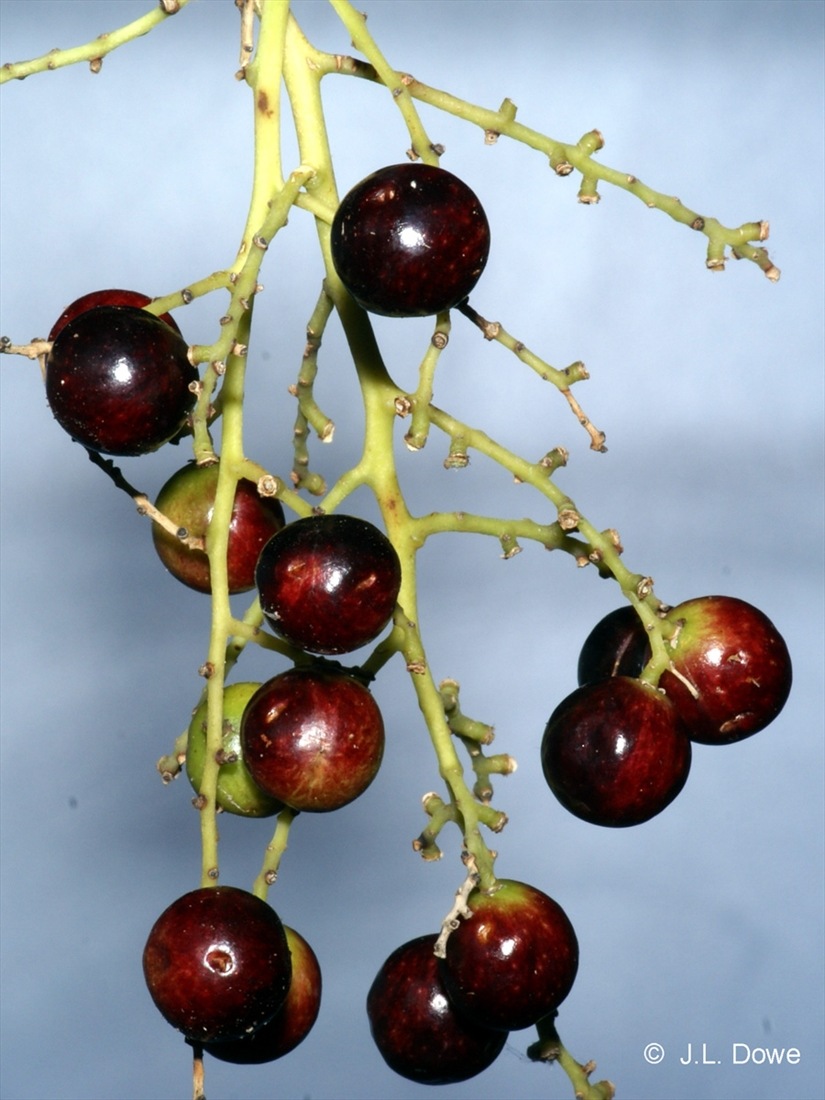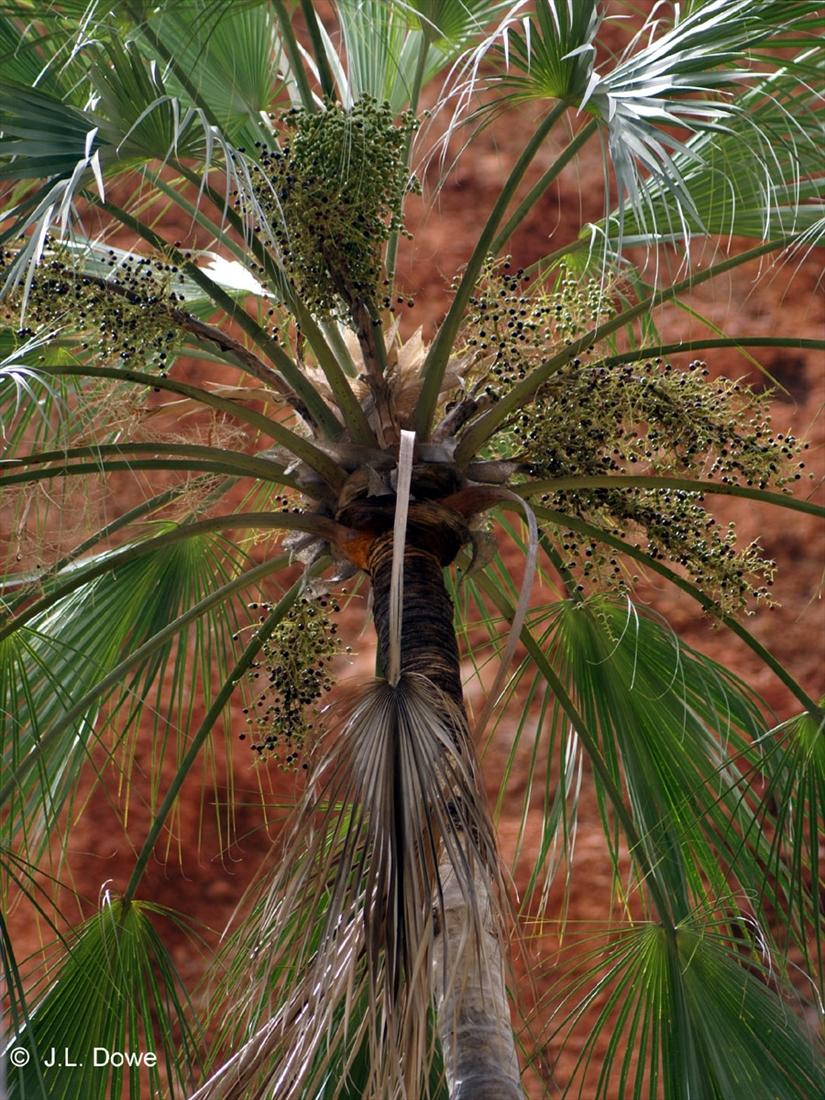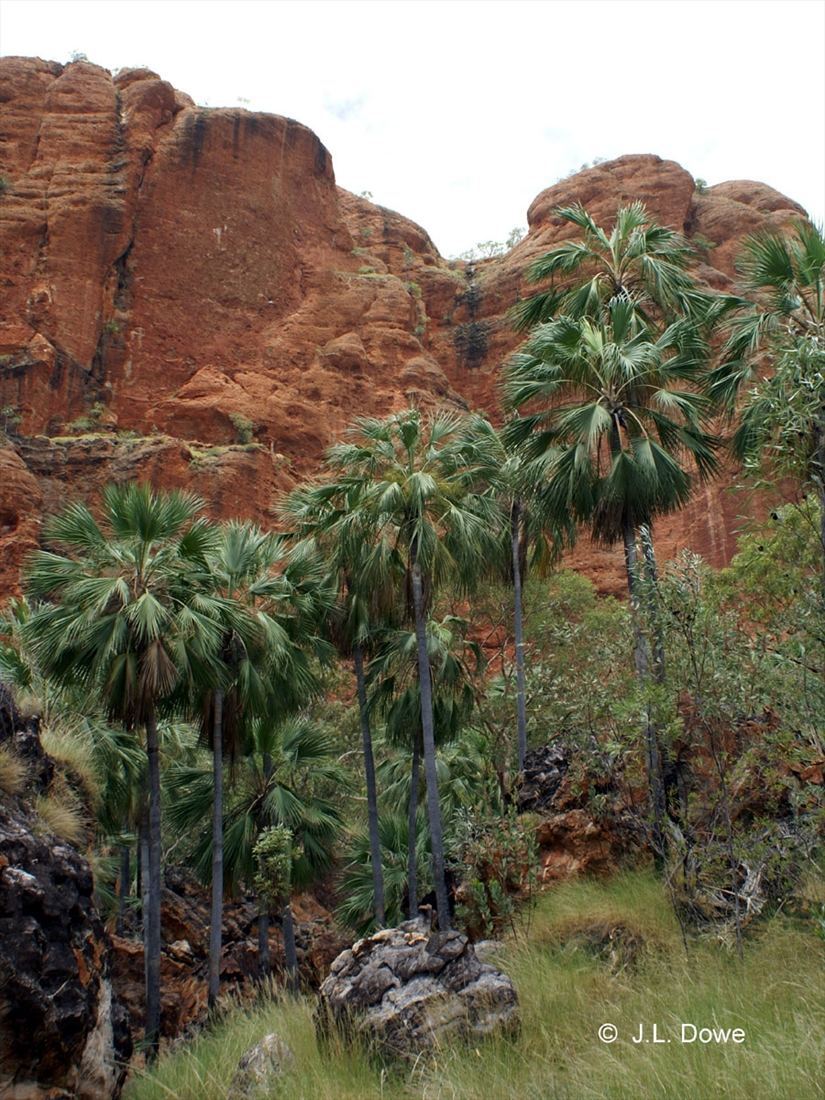Australian Tropical Rainforest Plants - Online edition
Livistona victoriae Rodd





Rodd, A.N. (1998) Telopea 8(1): 123. Type: Northern Territory: c. 3 km W (by road) of Victoria River crossing, Katherine-Kununurra road, 15 35 S, 131 06 E, alt. c. 80 m, A.N. Rodd 2934, 3 Nov 1974; holo NSW; iso DNA, K, PERTH.
Victoria River fan palm; Bungle Bungle Range fan palm
Trunk solitary, to 12 (-18) m high, ca. 20 cm diameter at 1 m above ground, hardly reducing upward, broadening close to ground into a somewhat bulbous swelling to ca. 30 cm diameter. Surface rather obscurely ringed with sheath scars, becoming smooth on lower trunk with age; vertical fissures not very conspicuous; petiole-stubs ca. 4 cm long present on lowest 2-3 m of trunk, closely appressed with irregular, abraded or somewhat ragged ends. Plants functionally male or female.
Crown rather open, with pale blue-grey cast, globose or slightly elongated, consisting of 30-40 leaves with gently arching to drooping petioles, the leaf-blades continuing in the same plane with straight segment-lobes but conspicuously decurving costa. Ligules prominent, whitish or pale brown, contorted, subglabrous, strongly impressed between fibres, tearing early from petioles but leaving large, roughly triangular remnants attached to them. Petiole 100-110 x 2.2-2.8 cm, strongly flattened-triangular in cross-section. Margins obscurely denticulate or toward base armed with irregularly scattered blunt, prickles up to ca. 2 mm long. Surfaces pale dull pinkish, strongly pruinose, obscurely and finely striate; lower surface, and to a lesser extent upper. Hastula flat; base narrowly V-shaped to somewhat ovate-apiculate, often very asymmetric. Lamina 90-110 cm long, strongly costapalmate, with broad basal sinus, fairly stiff and harsh, tough and not readily split; strongly contorted with 1 adaxial undulation either side of the strongly deflexed costa.Segments 20-28 either side of costa; largest segments 29-40 mm wide, free for 55-65% of their length, tapering slightly toward point of bifurcation, bifurcated for 55-70% of free length, the lobes evenly tapering but attenuated at apices into slender, necrotic threads, breaking off with age. Intersegmental appendages present, moderately persistent, straight, white, mostly ca. 5 cm long. Major longitudinal veins 9-11 either side of abaxial rib, moderately prominent above, less prominent below; transverse veins moderately prominent on both surfaces. Surfaces concolorous, strongly pruinose, glabrous except for ribs bearing scales and brown markings as on petiole.
Inflorescences variable in length, from slightly shorter than petioles to about petiole plus half lamina length. Partial inflorescences 5-9, subequal, the largest slightly over half total inflorescence length; rachillae 0.4-3 cm long, 0.4-0.6 mm thick, cream when fresh, glabrous; larger axes striate, often very sinuous; all axes minutely papillose. Rachis bracts usually loose and distorted, becoming split and raggedly fibrous with age, thick and harsh-textured, straw-coloured aging silver-grey though more reddish-brown toward apices, finely striate, unevenly but often densely woolly with closely appressed, matted, somewhat curly, narrow white scales; bract apices elongated, acute or obtuse, never cuspidate. Flower-clusters 0.5-3 mm apart, 1-2-flowered; cluster axis 0.2-0.7 mm long, cylindrical, moderately slender; longer cluster axes often with lateral flower closer to base than apex. Cluster-bract very short, rounded or minutely apiculate. Bracteoles not detectable. Anthopodium ca. 0.5 mm long, bulging downward at base. Sepals membranous, closely appressed to petals, connate for over half their length with very broad shallow sinuses, triangular, acute. Petals ca. 1.2 mm long, rather narrowly triangular-ovate, acute and cymbiform at apex; inner face with 3 fairly deep cavities. Stamens at least 75% as long as petals, connate for ca.25% their length; filaments broadly triangular-ovate, tapering smoothly to an elongated slender apex.
Fruit spherical-ellipsoid, strongly flattened adaxially, ca. 11 x 10 mm, abruptly narrowed at base into a very short conical extension, ventral suture evident. Epicarp reddish-brown or grey-brown, minutely verruculose. Mesocarp very thin, deep red-brown on inner surface. Endocarp ca. 0.15 mm thick. Seed ca. 9 mm long, flattened on adaxial face.
Features not available.
Occurs in WA and the NT between the Victoria River basin and the Bungle Bungle Range. Altitudinal range from 50-350 m. Confined to sandstone range country where it grows in rocky gorges, escarpment gullies and cliffs bases, and along streams and intermittent watercourses. All habitats with permanent seepage water available to its roots. Grows in gallery forest and eucalypt woodland.





